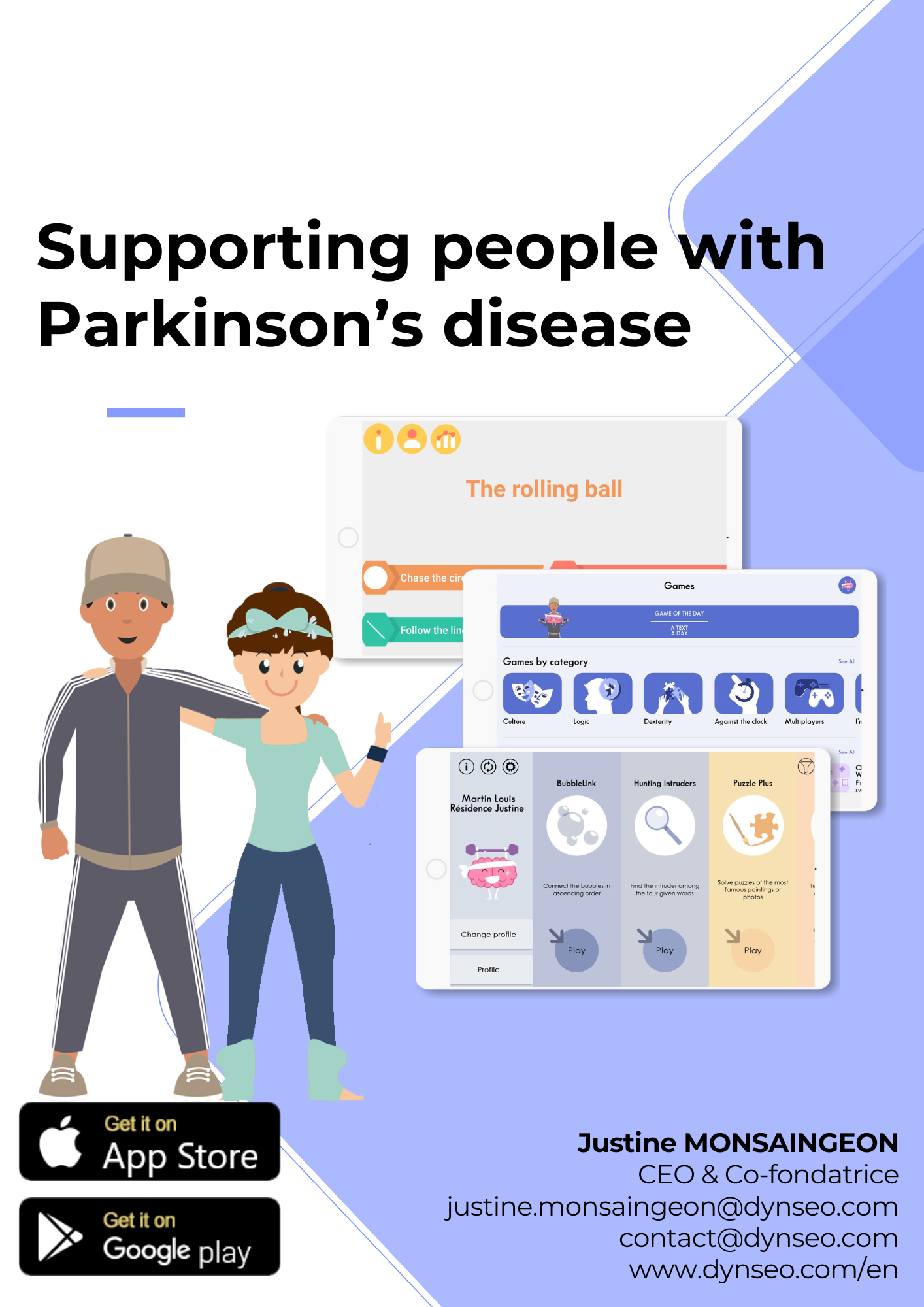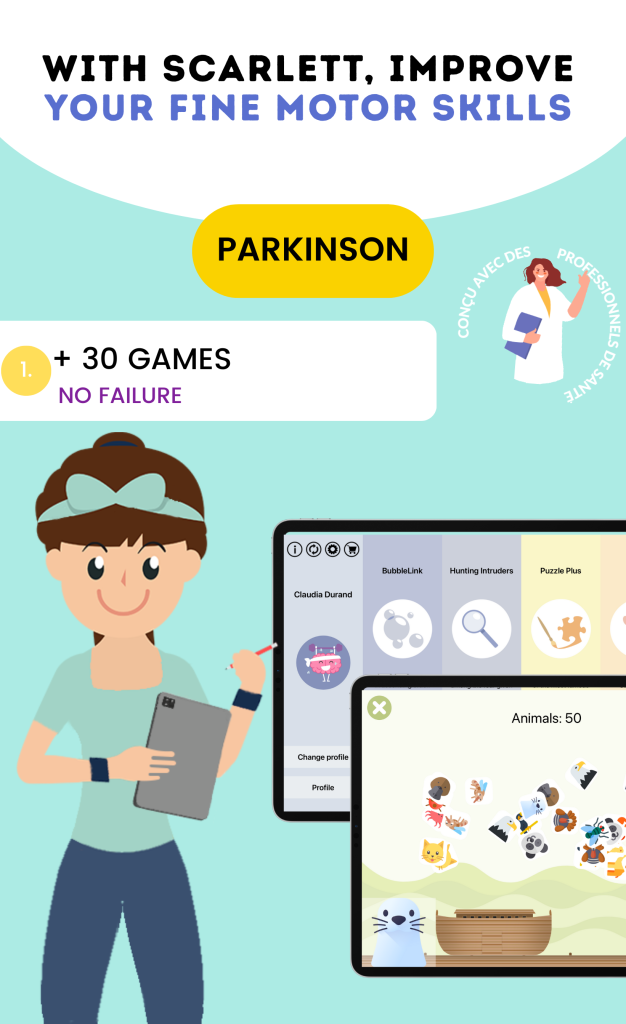Communication is a bridge we build every day to connect with others. When Parkinson’s disease enters the scene, this bridge can seem more fragile, more difficult to cross. The muscles we use to speak, articulate, and voice our thoughts are also affected by the changes the disease imposes on the body. Speech, once fluid and spontaneous, can become a source of frustration and isolation.
Here, we believe that everyone has the right to make their voice heard and to maintain that precious connection with their loved ones. That’s why we develop tools and share knowledge to help strengthen this bridge. This article aims to enlighten you about the speech disorders related to Parkinson’s disease and, most importantly, to present concrete techniques and tools, including our applications, to support you and your loved ones on the path to better communication.
Before seeking solutions, it is essential to understand why speech is affected. It is not a problem of comprehension or vocabulary, but rather a motor challenge. It’s a bit like if the conductor (the brain) is having difficulty giving clear and synchronized instructions to its musicians (the speech muscles).
Why is speech affected?
Parkinson’s disease is characterized by a decrease in dopamine production, a neurotransmitter crucial for movement control. This deficiency leads to well-known motor symptoms such as slowness (bradykinesia), rigidity, and tremors.
It involves the perfect coordination of over a hundred muscles: those of the diaphragm for breath, vocal cords for sound, tongue, lips, and cheeks for articulation.
When these muscles become stiffer and less responsive, the entire mechanism gets stuck. The breath is less powerful, the voice loses volume, and the words are less distinct from one another. The medical term to describe this set of symptoms is hypokinetic dysarthria, “hypo” meaning “less” and “kinetic” referring to movement.
Common manifestations: the fading voice
Hypokinetic dysarthria can manifest in several ways, which vary from person to person. Recognizing these signs is the first step to taking action.
Here are the most frequent symptoms:
- A weak voice (hypophonia): This is often the first sign. The person speaks at a very low volume, as if whispering, and has difficulty being heard, especially in a noisy environment. They often are not aware of speaking so softly.
- A monotone speech: The melody of the sentence disappears. The intonation becomes flat, without the pitch variations that allow for the expression of emotions or to mark the difference between a question and a statement.
- An imprecise articulation: Consonants are “swallowed”, syllables collide, giving the impression that the person is mumbling. Words become blurred and difficult for the listener to decipher.
- An altered speech rate: The rhythm can be either too slow, with hesitations, or, paradoxically, speed up uncontrollably (festination), as if the words are jostling to come out.
- A hoarse or shaky voice: The quality of the voice itself can change, becoming more breathy or unstable.
These difficulties can make conversation exhausting, both for the speaker and the listener, sometimes leading to withdrawal.
Strategies and techniques to improve daily communication
Fortunately, there are many strategies to counter these effects and regain control of one’s speech. The key is regular practice, combining the support of a professional with daily exercises and adaptations to the environment.
The central role of the speech therapist
The speech therapist (or logopedist in Belgium and Switzerland) is your best ally in this journey. This health professional specializes in communication and swallowing disorders. After a complete assessment, they will set up a personalized rehabilitation program.
One of the most recognized and effective methods is the LSVT LOUD (Lee Silverman Voice Treatment) method. Its principle is simple yet powerful: “Think loud to speak loud”. The goal is to retrain the brain to produce a louder and clearer voice by focusing on a single objective: vocal intensity. Through intensive exercises, the person relearns to calibrate their voice so that it is perceived at a normal volume by others. The speech therapist is the indispensable guide to applying this method and many other techniques.
Exercises to practice at home
Rehabilitation does not stop at the therapist’s door. Like in sports, daily training is fundamental to maintain gains. Here are some types of exercises, to be validated with your speech therapist, that you can integrate into your routine.
- Breathing exercises: A strong voice starts with powerful breath. Practice abdominal breathing: sitting or lying down, place one hand on your belly. Inhale deeply through your nose while feeling your belly expand, then exhale slowly through your mouth while controlling the airflow.
- Vocal exercises: “Warm up” your vocal engine. Hold a vowel like “ahhhh” for as long and as loudly as possible. Do scales, going up and down in pitch to work on the melody of your voice.
- Articulation exercises: Loosen up the muscles of your mouth. Exaggerate the movements of your lips and tongue while pronouncing syllables (“pa-ta-ka”, “la-la-la”). Read a text aloud while articulating each word very clearly.
Adapting your environment and habits
Sometimes, small changes in our habits can make a big difference. It’s about creating optimal conditions for communication.
- Reduce background noise: Turn off the television or radio before starting a conversation.
- Face your interlocutor: Eye contact helps with understanding and allows the other to read your lips.
- Take your time: Think about what you want to say before speaking. Pause between sentences to catch your breath.
- Announce the topic: Start with a simple sentence to introduce the theme of the conversation, this will help your interlocutor follow along.
The support of technology: our tools to assist you

Today, technology offers innovative solutions to complement the work done with the speech therapist. Here, we have developed applications specifically designed to be training partners, fun and effective. They do not replace the therapist, but they are an excellent way to continue the work at home, independently and motivatingly.
Edith & Joe: a tailored and stimulating brain training
Speech is not just a matter of muscles. It also depends on our cognitive abilities: attention to stay focused on the conversation, memory to find words, planning to structure sentences. However, Parkinson’s disease can also affect these functions.
This is where our brain training program Edith & Joe comes in. Designed in collaboration with health professionals, it offers adapted cognitive games that specifically stimulate various executive functions. Many patients with Parkinson’s disease, as well as their speech therapists, use Edith & Joe as a complementary tool. By working on concentration, processing speed, or mental flexibility, the person strengthens the cognitive foundations necessary for smoother communication. It’s a bit like maintaining the brain’s control room so that the orders sent to the speech muscles are clearer and faster. The application becomes a true personal coach, available at any time for a training session.
The Rolling Ball: beyond speech, fine motor skills
Parkinson’s disease is a global impairment of the motor system. While Edith & Joe focuses on the brain, our application The Rolling Ball specifically addresses fine motor skills, particularly of the hand and wrist. What is the link with speech? The link is twofold.
Firstly, working on the precision and coordination of gestures on a tablet with a stylus contributes to general motor stimulation. This dexterity training can help maintain better overall motor control, which is beneficial for all activities, including speech.
Secondly, when speech is particularly difficult, writing can become an essential alternative means of communication.
Practicing with The Rolling Ball helps combat this phenomenon by working on the amplitude and fluidity of the writing gesture. Maintaining the ability to write, whether on paper or on a tablet, is to preserve a valuable communication channel and maintain autonomy.
The importance of the communication partner
Communication is a dance for two. The person with Parkinson’s disease makes considerable efforts to express themselves, but the quality of the exchange also greatly depends on the attitude of their interlocutor. Relatives, family, and caregivers have a crucial role to play.
Tips for relatives and caregivers
Being a good communication partner is primarily about showing patience and empathy. Your support can transform a frustrating conversation into a successful sharing moment.
- Be patient: Allow the person to finish their sentences. Do not interrupt them or speak for them, even if you think you know the end. This can be infantilizing and discouraging.
- Listen actively: Show that you are attentive by maintaining eye contact and nodding.
- Don’t hesitate to ask them to repeat: Do so kindly. Say “I didn’t quite understand the end of your sentence, could you repeat it?” rather than “What?”.
- Rephrase: Repeat what you understood in your own words. This helps validate understanding and correct misunderstandings without the person having to repeat everything.
- Ask closed questions: If the conversation is difficult, favor questions that require a “yes” or “no” answer to facilitate the exchange.
- Consider fatigue: Speaking requires immense effort. Choose times of day when the person is at their best to discuss important topics.
Maintaining dialogue and social connection
The greatest risk of speech disorders is isolation. The fear of not being understood or slowing down the conversation sometimes leads people to remain silent and avoid social interactions. It is essential to fight against this tendency. Continue to include your loved one in conversations, ask for their opinion, and share moments of conviviality. Non-verbal communication – a smile, a gesture, a squeeze of the hand – is just as important to maintain the bond.
Towards a holistic and positive approach
Living with the challenges of speech posed by Parkinson’s disease is not a fatality. It is a journey that requires commitment, but on which no one should feel alone.
Unity is strength: patient, speech therapist, and technology
Success relies on a partnership between three pillars. First, the involvement of the person themselves, through their motivation and regular practice of exercises. Next, the expertise of the speech therapist, who makes the right diagnosis, sets achievable goals, and guides rehabilitation. Finally, the support of technology, like our applications Edith & Joe and The Rolling Ball, which acts as an extension of therapeutic work, offering accessible, motivating, and personalized training on a daily basis.
Our tools are not magic wands, but companions designed to give you more power over your daily life, to help you work on your abilities, and to strengthen collaboration with your care team.
Living fully with Parkinson’s disease
Communication is like a muscle. With Parkinson’s disease, this muscle can weaken, but with the right training, the right strategies, and the support of those around you, it is possible to strengthen and keep it active. There will be easier days than others, fluid conversations, and moments of frustration. The important thing is not to give up, to celebrate every small victory, and to remember that every word spoken, every sentence shared, is a victory over the disease and a solid bridge built towards those you love. We are by your side to help you build and maintain these bridges, day after day.
In the article “Parkinson’s Disease and Speech Disorders: Techniques and Tools for Better Communication”, it is essential to understand how neurological disorders can affect communication. A related article that may interest readers is about managing the behaviors of patients with Alzheimer’s disease. This article, available on the Dynseo website, explores strategies for addressing behavior problems associated with this disease. To learn more, you can consult the article by following this link. Our guide for supporting people with Parkinson’s https://www.dynseo.com/accompagner-personnes-vivant-avec-parkinson/





